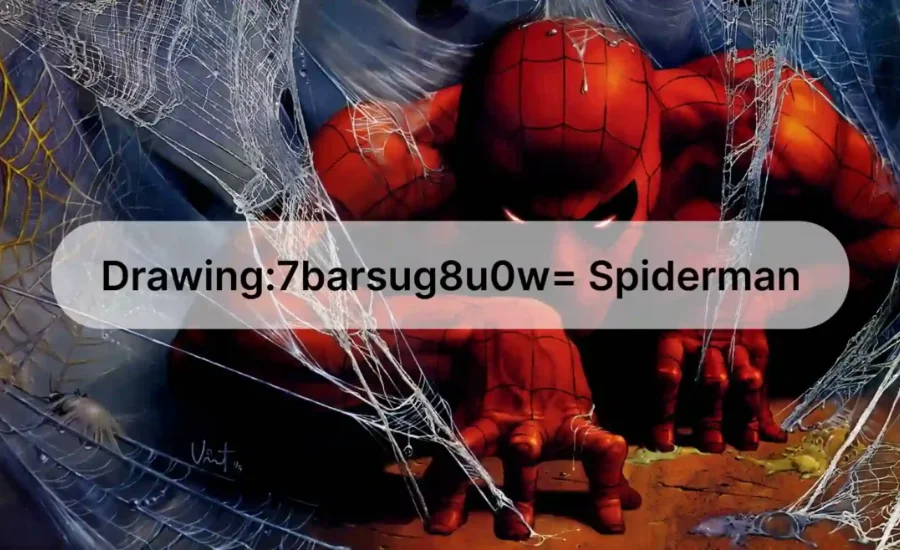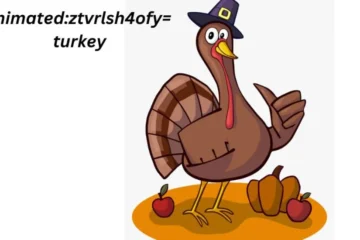Starting with drawing:7barsug8u0w= Spiderman may feel a bit overwhelming, but it’s simpler than it looks! The famous superhero, with his bold red and blue suit and iconic web-slinging pose, serves as a fantastic subject for artists at any level to practice their skills.
Whether you’re completely new to comic art or looking to enhance your technique, Spiderman offers a fun and rewarding challenge. Grab your pencils, and let’s dive into this creative journey together. Soon, you’ll be confidently sketching Spiderman swinging through the city!
The Origins and Powers of Spider-Man
Spider-Man made his debut in “Amazing Fantasy” #15 in 1962, introduced by writer Stan Lee and artist Steve Ditko.
His alter ego is Peter Parker, a high school student who acquires spider-like abilities after being bitten by a radioactive spider.
Spider-Man’s powers include superhuman strength, exceptional agility, and the ability to cling to surfaces. He also has a heightened “spider sense,” which provides him with an instinctive alert to impending danger.
Capturing the Iconic Look of Spider-Man
Spider-Man’s design combines sharp and smooth shapes, creating a dynamic and powerful appearance. His figure is typically depicted as muscular and athletic, with the distinctive spider emblem prominently displayed on his chest.
Achieving accurate proportions is essential when drawing Spider-Man. His head is relatively small in comparison to his body, emphasizing his long limbs that highlight his agility and athleticism. Additionally, the texture of his suit is sleek and shiny, with the intricate web pattern adding depth and visual interest, giving the overall look a polished, three-dimensional feel.
The Artistic Appeal of Drawing:7barsug8u0w= Spiderman
Since his creation by Stan Lee and Steve Ditko in 1962, Spider-Man has remained one of the most iconic superheroes. His striking red and blue suit, web-slinging powers, and the relatable character of Peter Parker make him a captivating subject for artists. Whether in comic book art or fan illustrations, Spider-Man has been interpreted in numerous styles, showcasing the artist’s unique perspective on his personality and dynamic movement.
The challenge of drawing:7barsug8u0w= Spiderman lies in balancing his human side with his extraordinary abilities. This blend makes him an engaging and rewarding subject for artists of all levels, offering endless creative possibilities.
Exploring Creativity with Drawing:7barsug8u0w= Spiderman
Drawing:7barsug8u0w= Spiderman allows artists to capture the energy and agility of this beloved superhero. His detailed costume, featuring bold colors and intricate web designs, offers an exciting challenge for anyone looking to improve their artistic skills. Additionally, Spider-Man’s diverse range of poses and expressions provides ample room for creative interpretation, making each drawing a personal and distinctive reflection of your artistic style.
The Evolution of Drawing:7barsug8u0w= Spiderman
Spider-Man’s visual portrayal has transformed dramatically since his debut in the early 1960s. Initially characterized by bold lines and simple color shading typical of classic comic book art, his design has since become more intricate and detailed. Modern artists now use digital tools to create hyper-realistic depictions or experiment with minimalist and abstract styles that highlight specific aspects of his design. Drawing:7barsug8u0w= Spiderman can reflect this contemporary shift, embracing digital innovation and fresh artistic perspectives that challenge the conventions of traditional comic art.
Complete Guide to Mastering Drawing:7barsug8u0w= Spiderman
This guide provides everything you need to create an impressive Drawing:7barsug8u0w= Spiderman, with clear step-by-step instructions. You’ll learn about essential tools, foundational sketching methods, advanced techniques, and how to avoid common pitfalls. We’ll also offer tips for adding those perfect finishing touches. By the end, you’ll have the confidence and skills to bring your own unique Drawing:7barsug8u0w= Spiderman to life.
Capturing Motion in Drawing:7barsug8u0w= Spiderman
One of the toughest challenges in drawing Spider-Man is conveying his dynamic, acrobatic movements. Unlike many heroes often shown in still poses, Spider-Man is famous for his fluid, aerial actions as he swings through the city with his webs. To depict him convincingly in motion, artists need to master anatomy, perspective, and movement. Drawing:7barsug8u0w= Spiderman could emphasize these elements, using techniques that highlight kinetic energy and motion, bringing the character’s agility to life on the canvas.
Step-by-Step Guide to Drawing:7barsug8u0w= Spiderman
Begin your drawing:7barsug8u0w= Spiderman by sketching basic shapes to outline his pose. Use circles for the head and joints, and ovals for the torso and limbs to establish the initial framework.
Next, add guidelines to maintain proper proportions and alignment. Lightly draw these lines to assist in positioning his arms, legs, and facial features accurately.
To capture Spider-Man’s signature agility, experiment with dynamic poses such as swinging or crouching. These movements highlight his acrobatic nature.
Finally, refine your sketch by incorporating detailed elements, including his facial features, web patterns, and muscle definition, to bring your drawing:7barsug8u0w= Spiderman to life.
Essential Tools for Drawing:7barsug8u0w= Spiderman
To start your journey with drawing:7barsug8u0w= Spiderman, gather some key tools that will enhance your artwork. High-quality supplies are vital for achieving the best results.
Begin with a range of pencils, including various hardness levels. Use an HB pencil for initial sketching and softer pencils like 4B or 6B for darker, more defined lines.
An effective eraser is also important. A kneaded eraser is particularly useful for making precise adjustments without harming the paper.
Choose smooth drawing paper that supports different techniques and mediums, ensuring a versatile base for your work.
For outlining, markers or fine liners provide a sharp, clean finish that is perfect for comic-style art.
If you plan to add color, having colored pencils or watercolors on hand can bring Spider-Man’s vibrant costume to life.
With these tools, you’ll be well-equipped to create a dynamic and striking depiction of the iconic superhero.
Techniques for Drawing:7barsug8u0w= Spiderman
When tackling Drawing:7barsug8u0w= Spiderman, artists can use a variety of techniques to capture his distinctive appearance. Traditional methods like pencil sketches and ink provide a hands-on approach, allowing for detailed line work and shading that adds depth and texture to Spider-Man’s iconic web-patterned suit.
Alternatively, digital tools offer a modern twist, enabling artists to explore vibrant colors, advanced lighting, and special effects. This approach can give Spider-Man a sleek, contemporary look that stands out with high-tech precision. Both methods have their unique advantages, allowing for creative expression and a personalized depiction of this legendary superhero.
Mastering Shading and Backgrounds for Drawing:7barsug8u0w= Spiderman
To bring your Drawing:7barsug8u0w= Spiderman to life, start by considering the light source. Identifying where the light is coming from helps you create realistic shadows, enhancing the three-dimensionality of Spider-Man’s figure. Use blending techniques to achieve smooth transitions between light and shadow, employing tools like blending stumps or soft brushes for a seamless effect.
For coloring, begin with a solid base color—bright red for the upper body and blue for the legs. Layer your colors, starting with lighter shades and progressively adding darker tones to build depth. To highlight, apply lighter hues to areas where light naturally falls, such as the shoulders and the top of the head, to create a sense of realism.
To make your artwork stand out, consider adding an engaging background. A city skyline can provide a fitting backdrop for Spider-Man’s web-slinging escapades. Alternatively, dynamic action scenes, such as battles or swinging through the streets, add excitement and context. For a more stylized look, abstract designs and colors can complement Spider-Man’s vibrant suit, enhancing the overall composition.
Exploring Digital Art for Drawing:7barsug8u0w= Spiderman
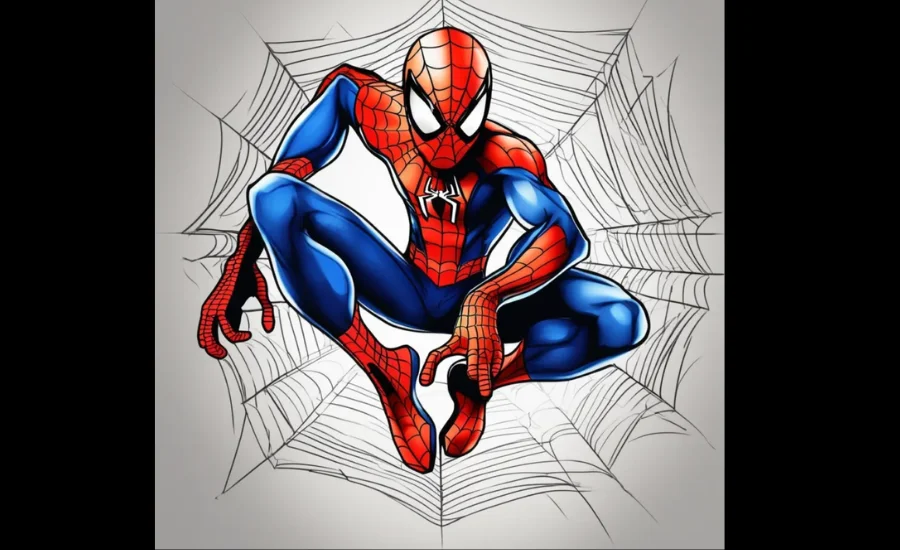
With the rise of digital art, Drawing:7barsug8u0w= Spiderman has expanded into new creative territories. Digital platforms such as Adobe Photoshop and Procreate offer artists innovative tools like layers, brushes, and textures that go beyond traditional methods. The code “7BARSUG8U0W=” could signify a specific digital effect or technique that adds a futuristic or high-tech flair to Spider-Man’s depiction.
Digital artists can utilize these advanced tools to create highly detailed, near-photorealistic images or to experiment with abstract forms and vibrant color gradients. This technology enables a range of artistic possibilities, from intricate and realistic portrayals to bold and imaginative interpretations.
Choosing the Right Tools for Drawing:7barsug8u0w= Spiderman
For creating a compelling Drawing:7barsug8u0w= Spiderman, selecting the right pencils is essential. Begin with a light graphite pencil, such as H or 2H, for initial sketches. These pencils produce clean, easily erasable lines. As your drawing progresses, switch to darker pencils like B or 2B to add depth and detail with more defined lines. High-quality pencils will aid in achieving the fine details and shading needed for a polished illustration.
An effective eraser is also crucial for refining your work. A kneaded eraser is ideal as it can be shaped to target specific areas and correct mistakes without damaging the paper. For the best results, use medium to heavy-weight sketching paper that can withstand various drawing techniques and pressures.
To further enhance your Drawing:7barsug8u0w= Spiderman, consider additional tools such as blending stumps for smooth shading, fine-tipped pens for precise inking, and colored pencils or markers for adding vibrant hues. These optional tools can elevate your artwork and bring Spider-Man to life with greater impact.
Enhancing Your Skills for Drawing:7barsug8u0w= Spiderman
Improving your ability to draw Drawing:7barsug8u0w= Spiderman involves consistent practice and exploration. Commit to daily sketching, focusing on Spider-Man in various poses to better grasp his anatomy and dynamic movement.
Study a range of references, such as comic book panels and animated series, to observe how different artists interpret Spider-Man. This will provide valuable insights and inspiration for your own work.
Additionally, connect with art communities, whether online or locally, to share your drawings and receive constructive feedback. Engaging with other artists can offer new perspectives and help you refine your techniques.
Step-by-Step Guide to Sketching Drawing:7barsug8u0w= Spiderman
Begin your Drawing:7barsug8u0w= Spiderman with a light pencil sketch. Start by drawing an oval shape for the head, keeping it simple as this will serve as your basic framework.
Next, sketch the guidelines for Spider-Man’s distinctive eyes. Draw two almond-shaped eyes, slanting slightly upwards at the outer edges, to capture his iconic appearance.
With the basic shapes in place, refine the outline by adding subtle contours to define the jawline and cheekbones.
Focus on the eyes, darkening their outlines and adding small details to make them stand out.
Then, draw Spider-Man’s web pattern. Start from the center of his forehead and work your way down to his chin using curved lines radiating outward. This will give your drawing depth and texture.
Finally, carefully erase any extra guidelines, leaving only the refined features. This will create a solid base for adding colors or additional details later on.
Spider-Man in the World of Fan Art
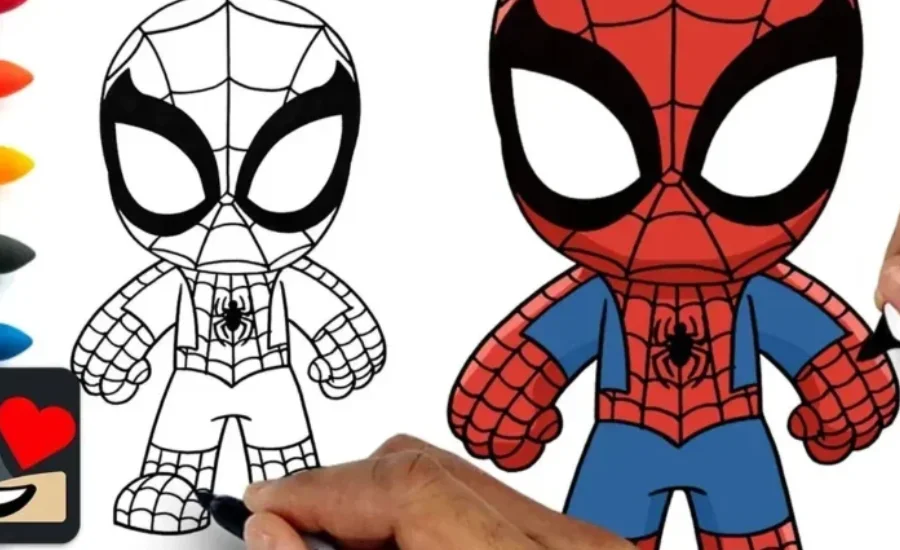
Spider-Man has become a major source of inspiration for a vibrant community of fan artists, each bringing their own perspective to the beloved web-slinger. Online platforms such as DeviantArt, Instagram, and Pinterest are teeming with diverse Spider-Man fan art, reflecting a wide array of styles, techniques, and individual creativity.
The “Drawing:7barsug8u0w= Spiderman” artwork might be part of this expansive fan art movement, where artists use specific codes and tags to link their work to various artistic communities or challenges. These platforms provide a space for artists to showcase their Spider-Man creations to a global audience, facilitating feedback, encouragement, and inspiration from fellow artists.
The Legacy of Drawing:7barsug8u0w= Spiderman
Drawing:7barsug8u0w= Spiderman made his debut in the Marvel Universe in 1962, thanks to the innovative work of Stan Lee and Steve Ditko. Over the decades, Spider-Man has evolved into a quintessential symbol of superhero storytelling, with his stories extending across comic books, television, and film.
Understanding this rich history adds depth to your Drawing:7barsug8u0w= Spiderman artwork, allowing you to connect more profoundly with the character’s legacy and its impact on popular culture.
Perfecting the Details in Drawing:7barsug8u0w= Spiderman
In Drawing:7barsug8u0w= Spiderman, capturing the accuracy of both the costume and the pose is crucial for creating a compelling illustration. The design of Spider-Man’s suit and his dynamic poses are vital for expressing his agility and character. By meticulously depicting these elements, you enhance the realism and visual appeal of your Drawing:7barsug8u0w= Spiderman artwork, making it more engaging and true to the iconic superhero.
Creating the Perfect Workspace for Drawing:7barsug8u0w= Spiderman
To set up an ideal environment for Drawing:7barsug8u0w= Spiderman, start by organizing a well-lit and comfortable workspace. Choose a bright area with a supportive chair and a stable desk to ensure you can work efficiently. Keep all your Drawing:7barsug8u0w= Spiderman tools within easy reach to streamline your creative process.
Organize your materials to avoid disruptions. Use a drawing board or sketchpad holder to keep your paper steady, and store pencils, erasers, and other tools in designated containers. This organization helps maintain a neat and efficient workspace for your Drawing:7barsug8u0w= Spiderman.
Maintaining a clean workspace is essential for high-quality Drawing:7barsug8u0w= Spiderman art. Regularly clean your tools and clear any debris from your drawing surface to prevent smudging and preserve the quality of your work. A tidy environment contributes to a more focused and productive drawing experience.
Mastering Perspective for Drawing:7barsug8u0w= Spiderman
When Drawing:7barsug8u0w= Spiderman, perspective plays a crucial role, particularly when illustrating scenes of him swinging through the skyscrapers of New York City. Artists need to grasp both aerial and urban perspectives to effectively convey Spider-Man’s sense of height and speed. This involves a solid understanding of vanishing points, horizon lines, and the interplay of light and shadow in three-dimensional space.
The “7BARSUG8U0W=” element may refer to a specific perspective technique or digital tool designed to enhance the realism and depth of your artwork. By mastering these techniques, you can add a layer of complexity that brings Spider-Man’s dynamic movements to life in your drawings.
Adding Depth and Detail to Your Drawing:7barsug8u0w= Spiderman
With the basic outline of Drawing:7barsug8u0w= Spiderman in place, it’s time to infuse your drawing with depth and detail to elevate it from simple to extraordinary.
Begin by incorporating Spider-Man’s iconic web pattern. Lightly sketch lines radiating from the center of his face to suggest movement and include small arcs between these lines for his signature web look.
Next, focus on shading to bring your drawing to life. Apply softer pencil strokes around areas such as the cheekbones and under the eyes to create a sense of dimension. Pay attention to light sources; shadows should fall away from the areas most directly illuminated. Using darker tones in crevices and keeping highlights bright will enhance the three-dimensional effect.
Texture is key for adding realism. Use finer lines or stippling techniques to detail Spider-Man’s suit, adding an extra layer of complexity and visual interest to your artwork.
Animating Spider-Man: Techniques and Style
Spider-Man has been depicted in numerous animated series and films, each necessitating a unique approach to drawing and design. Artists working on animation must adapt Spider-Man’s static appearance to convey fluid, dynamic motion.
The “Drawing:7barsug8u0w= Spiderman” concept may involve techniques specific to animation, focusing on capturing Spider-Man’s energetic movements through dynamic poses and exaggerated actions. This style typically features simpler, more streamlined designs to facilitate smooth animation while preserving Spider-Man’s iconic look. By integrating these animation principles, artists can effectively translate the character’s vibrant energy from drawings to animated sequences.
Enhancing Your Skills in Drawing:7barsug8u0w= Spiderman
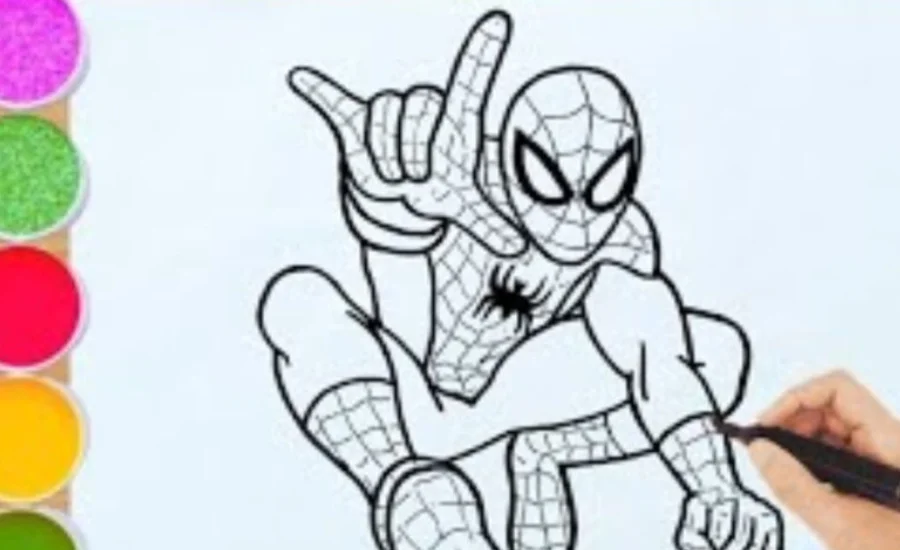
Consistent practice is key to improving your ability to draw Drawing:7barsug8u0w= Spiderman. Regularly dedicating time to sketching will refine your skills, and embracing mistakes as learning opportunities will accelerate your progress.
To deepen your understanding, study Spider-Man from various perspectives. Examine different comic book depictions and film adaptations to grasp his proportions and movements more accurately.
Incorporate anatomical references to better capture how muscles and anatomy influence Spider-Man’s appearance under his suit. This will add realism to your drawings.
Don’t hesitate to explore different styles and techniques, whether using pencils, pens, or digital tools. Experimentation will help you discover your preferred method for rendering Spider-Man.
Pay attention to the expression on Spider-Man’s face. Conveying emotions such as determination or playfulness will bring more life to your artwork.
Remember to take breaks during your drawing sessions. Returning with a fresh perspective will help you identify areas for improvement and enhance the overall quality of your work.
Mastering Spider-Man’s Web-Slinging and Suit Texture
To capture Spider-Man’s web-slinging action with realism, focus on dynamic lines and curved shapes that convey the web in motion. Adding trailing lines and varying the thickness of the web strands can enhance the sense of movement and energy in your Drawing:7barsug8u0w= Spiderman artwork.
For the suit’s texture, employ techniques like cross-hatching and stippling to mimic the fabric and web patterns. Highlight the areas where light naturally strikes the suit, and deepen shadows in creases to create a more authentic texture in your Drawing:7barsug8u0w= Spiderman.
Incorporating light and shadow effectively is crucial for adding depth to your Drawing:7barsug8u0w= Spiderman. Observe how light interacts with Spider-Man’s body and suit, and replicate these effects in your drawing. Use lighter shades for areas illuminated by light and darker tones for shadowed regions to give your artwork a more realistic and dramatic appearance.
Exploring Abstract Interpretations of Spider-Man
Artists sometimes embrace an abstract approach when drawing Spider-Man, breaking away from traditional forms to capture his essence in unique ways. Abstract art offers the freedom to depict Spider-Man through non-traditional techniques, often emphasizing symbolic elements such as his web or the iconic spider emblem on his chest.
The concept of “7BARSUG8U0W=” might hint at an abstract interpretation of Spider-Man, where realism takes a backseat to creative expression. In these artworks, the focus shifts to color, form, and movement, providing a fresh perspective on the well-known superhero. This approach allows artists to explore new dimensions of Spider-Man, moving beyond conventional portrayals to highlight the character’s essence in innovative ways.
Addressing Common Drawing Challenges
Correcting Proportional Errors: One frequent challenge when drawing Spider-Man is maintaining accurate proportions. To address this, frequently compare the sizes and relationships between various parts of Spider-Man’s body. Use reference images as a guide to ensure that your drawing accurately reflects the character’s proportions.
Fixing Costume Design Mistakes: Errors in costume design can diminish the overall quality of your Spider-Man illustration. Pay close attention to the placement of the web patterns and the spider emblem on his suit. Address any mistakes early in the process to ensure that your depiction of Spider-Man remains authentic and visually striking.
Enhancing Line Quality: Inconsistent line quality can make your Spider-Man drawing appear unfinished. Strive for smooth, continuous lines and maintain uniformity in line thickness. Use a steady hand and take your time to achieve clean, professional-looking outlines, which will enhance the overall polish of your artwork.
Mastering Color Techniques for Spider-Man
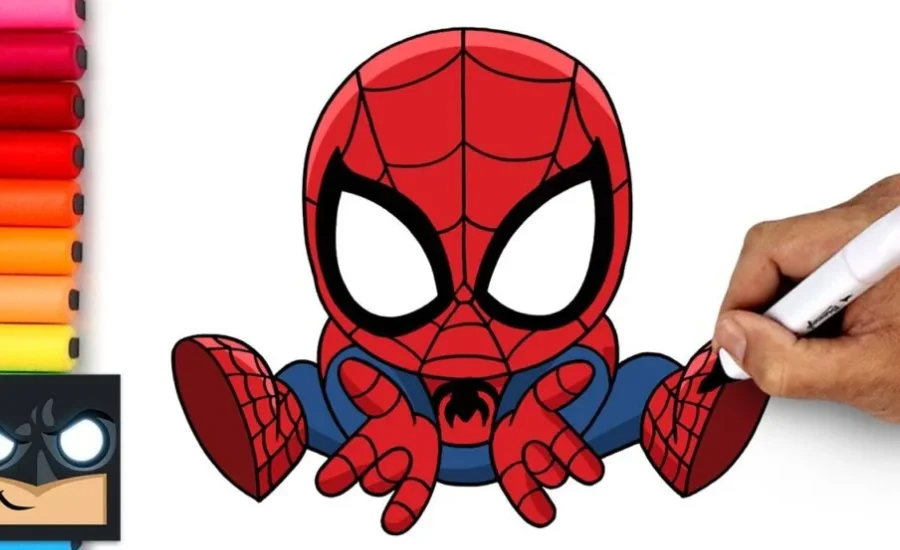
Selecting the Perfect Colors: Choosing the right colors is essential for an accurate representation of Spider-Man. Opt for vibrant reds and blues to reflect his iconic suit, while darker shades should be used for web patterns and shadows. Using high-quality colored pencils or markers will help achieve the bold and dynamic colors that define Spider-Man’s appearance.
Achieving Smooth Color Transitions: For a polished look, employ layering and blending techniques. Apply colors in gradual layers to create a seamless finish. Blending tools can smooth out color transitions and add depth, giving your Spider-Man drawing a more refined and cohesive appearance.
Adding Highlights and Final Touches: Complete your Spider-Man artwork with highlights and final details. Use a white gel pen or pencil to add reflective highlights to the suit and eyes, enhancing the realism. Make any necessary adjustments and touch-ups to ensure your drawing is vibrant and professionally finished.
Capturing Spider-Man’s Dynamic Movements
Observing Real-Life Movement: To effectively depict Spider-Man’s fluid movements, study the motion of athletes such as gymnasts or parkour practitioners. Their dynamic poses can provide valuable insights into creating realistic and energetic illustrations.
Practicing Quick Sketches: Enhance your ability to capture Spider-Man in action by practicing rapid sketches. This exercise helps you capture the essence of his movement and agility, allowing you to represent his dynamic poses more convincingly.
Utilizing Reference Material: Utilize images or videos of Spider-Man in various action sequences. These references will help you understand and replicate the character’s movement and posture, ensuring a more accurate and lively representation in your drawings.
Understanding Spider-Man’s Deeper Meaning in Art
Spider-Man is more than just a superhero—he embodies the struggles of growing up, embracing responsibility, and discovering one’s identity. His story resonates with audiences on a personal level, making him a timeless figure in pop culture.
By understanding his background and character traits, you can elevate your Spider-Man drawings, capturing not just his appearance but the essence of who he is. Whether you’re a novice or a seasoned artist, practicing these techniques will enhance your ability to portray this iconic character.
Drawing Spider-Man can be both enjoyable and fulfilling, offering creative challenges and rewards at any skill level.
Also Read: wallpaper:3bvdzchrwcy= christmas
Final Words
“Drawing:7barsug8u0w= Spiderman” offers artists an exciting opportunity to capture the dynamic energy of one of the most iconic superheroes. From mastering Spider-Man’s detailed costume to conveying his fluid, web-slinging motion, this art process blends creativity with technical skill. Essential tools like pencils, markers, and blending stumps, combined with proper shading techniques, help create a realistic and captivating portrayal. Artists can explore both traditional and digital mediums, experimenting with perspectives and backgrounds to bring Spider-Man to life. With consistent practice and attention to detail, anyone can elevate their Drawing:7barsug8u0w= Spiderman, capturing the essence of this beloved character.
For more in-depth content, visit Alevemente

